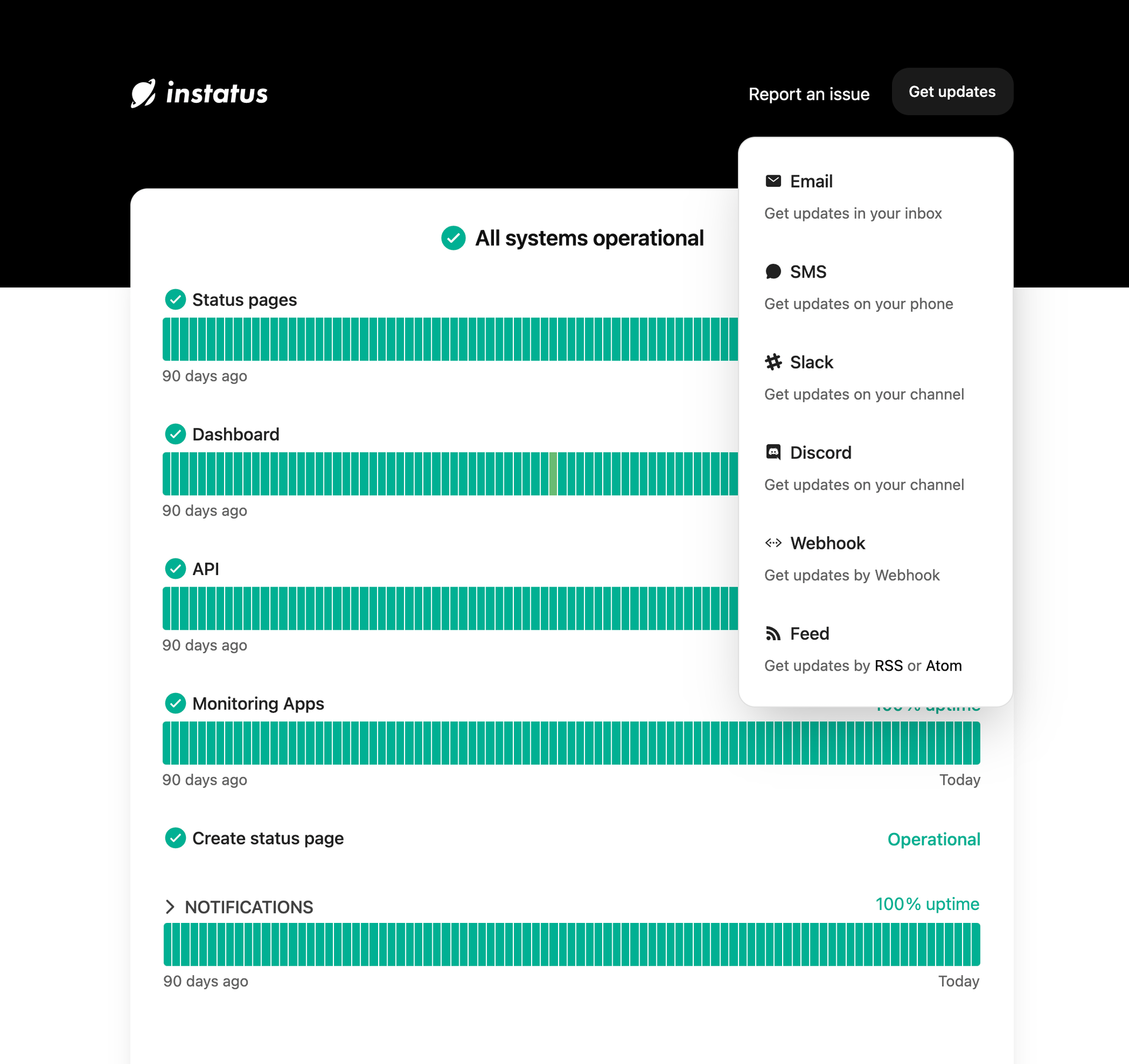A Guide to DevOps Project Management - Everything You Need to Know

If you’ve been part of the development world for long, you know that to achieve any organizational goal successfully, proper project management is a vital part of the process. Poor or even average project management is like a broken GPS. It may or may not get you where you want to go, and even if it does, chances are you won’t have taken the most straightforward route. In today’s development world, DevOps project management is an important part of any successful code release.
While Instatus can help when your application takes a turn for the worse, the goal is always to avoid downtime and wrinkles in your organization’s products. That’s where DevOps project management comes in. In this article, we’ll take a look at DevOps project management, including what it is, why it’s important, and its best practices.
DevOps vs. Project Management
Let’s dive into what a DevOps strategy is and how it relates to project management. The term “DevOps” is simply a combination of the terms “Developers” and “Operations”. It’s a software development strategy that was created to help the teams in an organization work together more efficiently to produce higher-quality products and apps.
Project management on the other hand relates to delivering something of value to people. Project managers are usually the ones keeping your deliverables on track, by making sure deadlines and quality guidelines are met.
What is DevOps project management?
With that in mind, let’s take a deeper look into what DevOps project management is. Similar to traditional project management, DevOps project management entails assigning tasks and managing timelines in order to help a team reach an overall goal.
The project manager designs a strategy to integrate the organization’s teams into a common, collaborative environment. This includes drawing in teams such as the developers, designers, and operations employees into a designated DevOps environment. They can also measure the effectiveness of the DevOps team and its processes with DORA metrics. This will help the company’s teams to understand each other’s motives and remain aligned on their shared goal of improving production speed and quality.
DevOps project management is a different take on traditional project management. It involves adopting a “CI/CD” approach, also known as Continuous Integration and Continuous Delivery, which aims to create a continuous cycle of software development and release. It’s an approach focused more on optimizing the process than on one finite end goal.
Why is DevOps project management important?
DevOps project management is important for many of the same reasons that you need a project manager for any business endeavor. DevOps project managers help ensure that timelines are met. They evaluate the project design, decide on milestones, and assign tasks to team members. They can even evaluate With a DevOps project manager, the overall goal of a DevOps approach, which is integrating teams from development and operations, is achieved.
Best practices for DevOps project management
DevOps project management is different from traditional project management. Here are some best practices for successfully managing a DevOps project:
1. Focus on quality and meeting deadlines
The whole purpose of DevOps is to streamline collaboration between teams, improving production times and delivering a quality product. A DevOps project manager will ensure that these objectives are met, by emphasizing communication throughout the DevOps feedback loop. This ensures that improvements are made to the product continuously
2. Let mistakes be lessons
When learning a new methodology, mistakes are bound to happen. Your team will be more fearless and successful in the long run if you approach mistakes through a lens of learning. What can you learn from each approach your team tries?
Promoting a culture of learning will help your team feel comfortable trying new things, even if there’s a chance they’ll fail. Failure is an important part of the process and will expedite the learning curve.
3. Adopt an MVP approach
No, MVP doesn’t mean “most valuable player”. In this case, MVP refers to “minimum viable product.” What does this mean, exactly? In software development, scope creep is a pervasive problem. It’s easy for projects to become more extensive and time consuming than they were ever intended to be. An MVP strategy means approaching each project with the goal to develop the most minimal application that will accomplish the goal of the project.
If you’re used to traditional project management, this might seem like an odd approach, because traditional project management is very much oriented towards the final product.
However, in DevOps project management, the focus is on continuous delivery and continuous integration, with less of an emphasis on the final product (although that’s important too).
With an MVP approach, the customers are involved much earlier in the process and can give valuable feedback before the project is complete.
This is better than delivering a massive project and later realizing it wasn’t what the customer was looking for in the first place. With an MVP approach, you’ll be able to avoid wasted time and resources.
4. Utilize the tools available to you
In a DevOps approach, automation is crucial, and it’s the same with DevOps project management. Using tools to help with the project management will help in all aspects of the project, including dividing and distributing tasks, accountability with due dates, and creating milestones for team members to reach.
Here are some of the best DevOps project management tools:
-
JIRA: Jira is a platform designed to assign tasks and track issues and their resolutions. With its user-friendly interface and many features designed for collaboration, using JIRA is a great way to manage issues, assign tasks, and track what items have been resolved.
Another great feature of JIRA is its compatibility with other tools. As JIRA is an Atlassian tool, it is designed to work flawlessly with Atlassian’s other tools, such as Confluence, BitBucket, and others.
-
AWS DevOps: With AWS Devops, your team will be able to develop software and manage tasks on the same platform. AWS Devops is not just one tool, but an entire group of tools that combine to form an IAAS (Infrastructure As A Service).
AWS Devops is designed to help with every part of the development process and can be used on a single machine or in the Cloud for greater versatility.
-
GitLab: Gitlab is a popular and useful tool for tracking team members’ contributions and coordinating tasks assigned to each team member. Gitlab allows you to create “issues” on the platform so your team can keep track of ongoing responsibilities and tasks.
-
Asana: Asana is another project management software similar to JIRA. With Asana, you can assign tasks, track them, and close them out when they’re finished. It provides a platform for your team to collaborate and for project managers to keep team members accountable for tasks assigned to them.
As a bonus, Asana is customizable, so project managers can implement rules and approval systems in order to better fit the needs of their team.
-
Azure Boards: Azure Boards is another useful project management tool, designed to assist project managers during every part of the software development lifecycle. Azure Boards allows project managers to create custom dashboards and reports for specific projects and task-tracking.
Azure Boards is also part of a larger collection of tools in the Azure DevOps Suite, making it a versatile and useful tool for project managers to use.
5. Train your organization across teams
An essential part of a successful DevOps strategy is improving collaboration within the organization. Making the switch to a DevOps approach can be a significant change within an organization.
It’s important to provide sufficient training across the different teams in your organization to create better support and resources.
6. Be prepared for change
A successful DevOps strategy necessitates change within an organization. This means adopting the use of new software to improve automation and integration, allocating resources to support the changes, and changing traditional workstyles to improve collaboration across teams.
Being prepared for changes in how your organization works will make you more successful as a DevOps project manager.
Summary
DevOps project managers are essential for any organization seeking to adopt a DevOps strategy in their development cycle. With successful DevOps project management, your company can increase customer satisfaction, improve efficiency in production time, and produce better products overall.
However, as with anything in the development world, it’s important to be prepared for when things go wrong, as they inevitably will. Luckily, Instatus provides a way for your customers to remain satisfied and maintain trust even when your application goes into downtime.
Instatus provides a beautiful, elegant alternative to the traditional error messages that are usually bothersome and pesky to users. Instead, your users will enjoy a user-friendly, intuitive status page that will keep them happy even during downtime.
This will help you avoid excessive tickets, and user frustration, and Instatus is offered at an affordable price too. Try the free status page available from Instatus today to see how it will benefit your organization.
Get ready for downtime
Monitor your services
Fix incidents with your team
Share your status with customers


